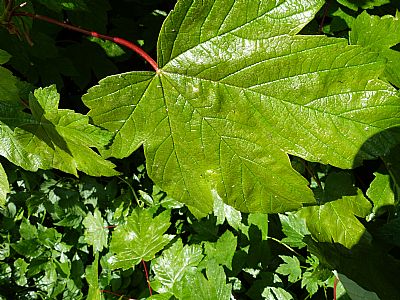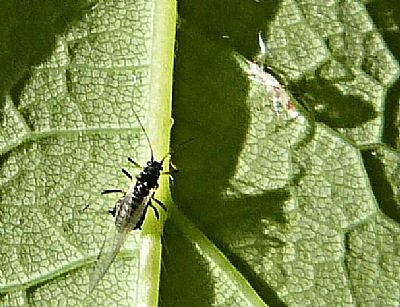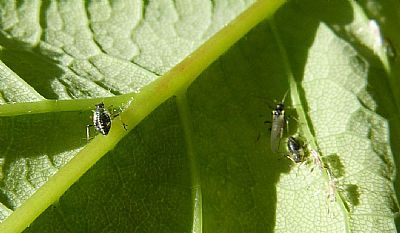SYCAMORE APHID : Drepanosiphum platanoidis
This aphid lives almost solely on the underside of the leaves of the sycamore tree. The result is a shiny and sticky upper surface coated with honeydew, the excretion from these tiny creatures. Few people notice them, but next time you see the shiny leaves, turn one over and you should find a number of them.
While other insects may join them, what you see is evidently different life stages of this tiny insect. An aweful lot of them; It is quite remarkable how they can affect so many trees and so much of them. A mature sycamore can host up to 2 1/2 million of them. While they feed on the trees they do not detrimentally affect them. And being fond of sycamores, do not affect other plants.
Welcome Open Rearch gives a formal description which is quoted in length as it is fascinating. The Common Sycamore Aphid, Drepanosiphum platanoidis (Schrank, 1801), is a holocyclic aphid, feeding and reproducing on sycamore, Acer pseudoplatanus L .... All adult D. platanoidis are winged, most are green, although a small percentage can be red, and they can develop dark cross-bars on their abdomen ... D. platanoidis is found wherever sycamore occurs, mostly in Europe and the UK, but also in the USA, Canada, New Zealand, central Asia, and North Africa...
The lifecycle of D. platanoidis is closely linked to the nutritional value of the sycamore phloem. In the spring, the fundatrices emerge and begin asexual reproduction in response to the high nutritional value of the host phloem associated with bud burst and leaf flushing. Following this period of rapid population growth, they enter a period of aestivation of up to 8 weeks throughout the summer when conditions, such as rainfall, are less favourable ... In the autumn when the nutritional value increases once again, D. platanoides resumes feeding and reproduction. At this time, sexual male and females are produced, which subsequently mate, resulting in the laying of overwintering eggs ..... Ploem is the living tissue that transports the soluble organic compounds made during photosynthesis, in particular the sugar sucrose.

The shiny and sticky upper leaves of a sycamore in spring.


Two pictures taken in the 1st week in May. Notice how those two to the bottom right blend in colourwise and are hardly discernible except for their shadows.
INFLUENTIAL POINTS.COM : https://influentialpoints.com/Gallery/Drepanosiphum_aphids.htm
NATURESPOT : https://www.naturespot.org/species/sycamore-aphid
WELCOME OPEN RESEARCH : https://wellcomeopenresearch.org/articles/8-481
WIKIPEDIA : https://en.wikipedia.org/wiki/Drepanosiphum_platanoidis

